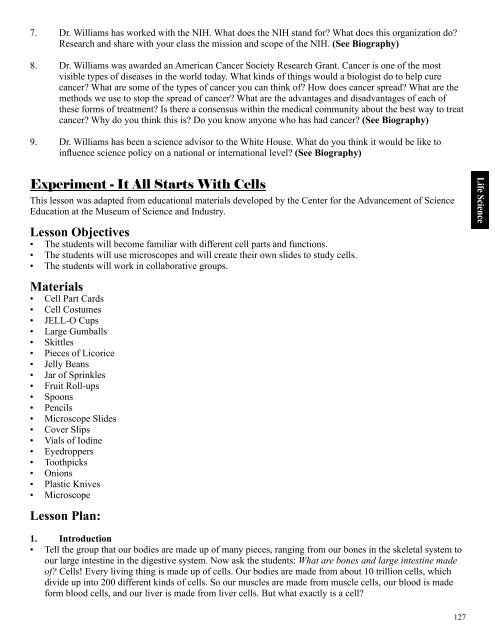ScienceMakers Toolkit Manual - The History Makers
ScienceMakers Toolkit Manual - The History Makers
ScienceMakers Toolkit Manual - The History Makers
You also want an ePaper? Increase the reach of your titles
YUMPU automatically turns print PDFs into web optimized ePapers that Google loves.
7. Dr. Williams has worked with the NIH. What does the NIH stand for? What does this organization do?<br />
Research and share with your class the mission and scope of the NIH. (See Biography)<br />
8. Dr. Williams was awarded an American Cancer Society Research Grant. Cancer is one of the most<br />
visible types of diseases in the world today. What kinds of things would a biologist do to help cure<br />
cancer? What are some of the types of cancer you can think of? How does cancer spread? What are the<br />
methods we use to stop the spread of cancer? What are the advantages and disadvantages of each of<br />
these forms of treatment? Is there a consensus within the medical community about the best way to treat<br />
cancer? Why do you think this is? Do you know anyone who has had cancer? (See Biography)<br />
9. Dr. Williams has been a science advisor to the White House. What do you think it would be like to<br />
infl uence science policy on a national or international level? (See Biography)<br />
Experiment - It All Starts With Cells<br />
This lesson was adapted from educational materials developed by the Center for the Advancement of Science<br />
Education at the Museum of Science and Industry.<br />
Lesson Objectives<br />
• <strong>The</strong> students will become familiar with different cell parts and functions.<br />
• <strong>The</strong> students will use microscopes and will create their own slides to study cells.<br />
• <strong>The</strong> students will work in collaborative groups.<br />
Materials<br />
• Cell Part Cards<br />
• Cell Costumes<br />
• JELL-O Cups<br />
• Large Gumballs<br />
• Skittles<br />
• Pieces of Licorice<br />
• Jelly Beans<br />
• Jar of Sprinkles<br />
• Fruit Roll-ups<br />
• Spoons<br />
• Pencils<br />
• Microscope Slides<br />
• Cover Slips<br />
• Vials of Iodine<br />
• Eyedroppers<br />
• Toothpicks<br />
• Onions<br />
• Plastic Knives<br />
• Microscope<br />
Lesson Plan:<br />
1. Introduction<br />
• Tell the group that our bodies are made up of many pieces, ranging from our bones in the skeletal system to<br />
our large intestine in the digestive system. Now ask the students: What are bones and large intestine made<br />
of? Cells! Every living thing is made up of cells. Our bodies are made from about 10 trillion cells, which<br />
divide up into 200 different kinds of cells. So our muscles are made from muscle cells, our blood is made<br />
form blood cells, and our liver is made from liver cells. But what exactly is a cell?<br />
127<br />
Life Science










